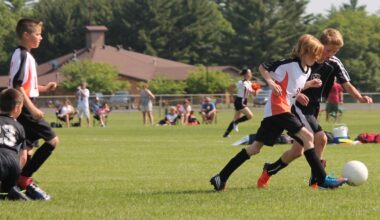Simple Reaction Drills to Play Tennis Sharper and Faster
Tennis is a game that requires excellent speed and quick reactions to succeed. To improve your overall performance, it’s essential to incorporate specific reaction drills into your training. These drills enhance hand-eye coordination, agility, and your ability to respond swiftly to opponents. The key is to focus on varied movements that mimic real game scenarios. Try setting objectives for each drill, allowing you to gauge your improvements over time. A well-rounded fitness routine that targets speed is crucial for elevating your game to greater heights. Consistency in practicing these exercises will lead to observable results on the court, improving both your reflexes and confidence. Work on drills in not only singles but also doubles situations, as these can present differing challenges. Additionally, vary the speed and intensity of your drills, giving yourself opportunities to adapt to various scenarios. Tennis fitness isn’t solely about strength; agility plays an integral role too. Hence, make a point to regularly include these reaction drills in your routine for optimal progress. Ultimately, these strategies will prepare you for real matches, allowing you to play sharper and faster than ever before.
Agility Ladder Drills
Agility ladder drills are fantastic for enhancing foot speed and coordination, essential qualities for any tennis player. To perform an agility ladder drill, lay out an agility ladder flat on the ground. Begin by stepping through the rungs of the ladder, focusing on quick, light foot movements. Experiment with various patterns, such as in-and-out motions, lateral shuffles, and even crossing your feet for added complexity. Each drill variant aids in improving your quickness and lateral movement, so implement a repertoire of movements. Be sure to maintain an upright posture, and keep your eyes forward as you navigate through the ladder. To further challenge yourself, consider accelerating the pace as you become more comfortable. You could also integrate ball handling into your agility drills by tossing a ball with a partner or aiming to catch a ball thrown by someone else while proceeding through the ladder. Modify your drills based on your tennis goals, whether you seek to improve your serving power or net game. Regular practice not only boosts your reaction time but also fosters overall speed improvement, enabling you to outmaneuver opponents with ease.
Another effective reaction drill is the cone drill, which emphasizes quick directional changes. Set up cones in various formations across the court, such as zigzag or circular patterns. Start at a central cone and sprint to the designated cones, touching each one, and returning to the center. This drill challenges not just your speed but also your ability to pivot and accelerate in different directions swiftly. As you progress, experiment with your starting position or add more cones to increase the complexity of the drill. Ensure to keep your body low and utilize your arms effectively to maintain balance. Incorporating both approach and retreat movements will further enhance your court coverage. To turn this into a competitive exercise, engage a training partner and race each other. Taking turns will also allow you to observe and enhance reaction speed under pressure. Always remember to warm up adequately to prevent injuries, and consider integrating these drills into your weekly training sessions. The focus here is on quality repetitions, so prioritize form and precision over speed. Over time, these cone drills will become second nature, greatly improving your responsiveness during match play.
Reaction Ball Drills
Utilizing a reaction ball can significantly sharpen your hand-eye coordination as you prepare to respond during tennis matches. These specially designed balls bounce unpredictably, challenging players to react quickly and accurately. Begin by bouncing the reaction ball on the floor and trying to catch it as it rebounds. As you gain confidence, throw the ball against a wall or use a partner for added difficulty. This drill trains your reflexes while improving catching ability—a crucial skill when dealing with volleys. Coaches recommend implementing a variety of catch techniques, such as using one hand or specific grips, to maximize your adaptability during play. The randomness of the ball’s bounce mirrors the inherent unpredictability of your opponent’s shots. Set timeout challenges with a partner to see who can catch the most rebounds within a minute. By repeatedly practicing these drills, you can enhance not only your reaction time but also your overall fitness. Additionally, make sure your training sessions include a mixture of stationary and mobile exercises. The dynamic nature of reaction ball drills ensures you are continually refining your skills, preparing yourself for the fast-paced interactions of competitive tennis.
Shadow tennis is a beneficial workout that enhances reaction time, quickness, and overall match readiness. To perform this drill effectively, find an open space where you can simulate tennis movements without a partner. Visualize an imaginary opponent, imagining their serves, volleys, and groundstrokes. Mimic the footwork and strokes necessary to return shots or counter your opponent’s plays. In this drill, focus on your foot positioning and on achieving optimal swing mechanics, even against an invisible player. Integrate lateral movements as well to ensure a well-rounded training routine. The aim here is to develop your court awareness and improve muscle memory, thus creating a more fluid response to in-game scenarios. Challenge yourself by increasing the intensity, speeding up your motions, or adding in stroke variations. Encourage a rhythm of movement that mimics quick match rallies; the more time you spend on shadow tennis, the better your instincts will become. Although shadowing may seem simplistic, it’s an effective way to engrain your skills into muscle memory, translating to enhanced performance on the actual court where reflexes are essential.
Partner Reaction Drills
Partner reaction drills foster competitive spirit and improve your quickness on the court effectively. Work with a training partner to practice your reaction times by creating unpredictable situations. Use a tennis ball and practice rapid exchanges of volleys, testing each other’s reflexes in real time. One effective drill includes standing about six feet apart, with one person tossing the ball randomly in different directions while the other tries to catch it. This exercise mimics the unexpected situations faced during actual matches and sharpens your reflexes accordingly. The key focus here is on agile movements and perfecting shot execution when the ball comes your way. As you develop comfort with the drill, increase the distance between you and your partner for a more challenging workout. You can also integrate footwork exercises, running towards the ball quickly and returning it to your partner, maintaining high energy levels throughout the workout. Adding spin to experimental shots increases the difficulty level further. Consistent practice of these drills will undoubtedly enhance your reaction capabilities, enabling you to handle unexpected shots during high-pressure situations on the court.
In addition to drills, implementing specific warm-up routines can also significantly improve your reaction times. Warming up prepares your muscles and joints for intense activity, reducing the risk of injury while enhancing overall performance. Engage in dynamic stretches such as arm circles, leg swings, and torso twists to stimulate blood flow. Focus on exercises that elevate your heart rate and coordination, promoting a good physiological response before training. Consider incorporating quick footwork exercises such as high knees or butt kicks, which can augment your agility and speed. As a tennis player, a solid warm-up not only prepares your body but also mentally prepares you for focused practice. Consider executing a light jog around the court for approximately five minutes, as this activity can elevate your cardiovascular efficiency. Ensure to hydrate adequately and allow enough rest between drills. Finally, always cool down post-session, implementing static stretches to increase flexibility and muscle recovery. A proper warm-up and cool-down routine is essential for longevity in sports performance. Adopting these habits can optimize the effectiveness of your entire training regimen, sharpening your reaction skills, and ensuring you stay fit.
Conclusion: Sharpen Your Skills!
Improving your speed and reaction time in tennis is an ongoing process that requires dedication and the correct set of drills. From agility ladders to shadow tennis and partner workouts, you have an arsenal of exercises at your disposal. Ensure you remain consistent in your practice and track the progress you make along the way. Integrating these drills into your training will lead to enhanced performance, allowing you to respond fluidly to your opponents’ actions. Always challenge yourself to push further, as mental resilience is just as critical as physical prowess. Remember, the best reaction times come from a combination of physical responsiveness and mental readiness. Leverage feedback from partners or coaches and tailor your drills to align with personal goals for maximum improvement. Stay motivated and embrace the challenge of becoming sharper and faster, translating practice into excellent on-court performance. By committing to these drills, you are setting yourself on a path toward success. Lastly, regularly revisit and adjust your routine to maintain progress, ensuring that your fitness regime evolves along with you. This proactive approach will not only enhance your game, but it will also foster a lifelong love for the sport.


